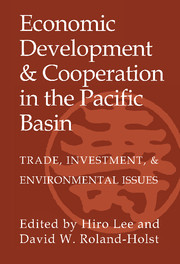 Economic Development and Cooperation in the Pacific Basin
Economic Development and Cooperation in the Pacific Basin Book contents
- Frontmatter
- Contents
- Acknowledgments
- List of Contributors
- I Introduction and Overview
- II U.S.-Japan and Asian Trade Patterns
- III Regional Trading Arrangements in the Pacific Basin
- IV Foreign Direct Investment: Determinants and Consequences
- 7 The Determinants of Foreign Direct Investment: A Survey with Applications to the United States
- 8 Are Trade and Direct Investment Substitutes or Complements? An Empirical Analysis of Japanese Manufacturing Industries
- 9 Korea's Outward Foreign Direct Investment and the Division of Labor in the Asia-Pacific
- 10 China's Absorption of Foreign Direct Investment
- 11 The Impact of Foreign Investment in Indonesia: Historical Trends and Simulation Analysis
- V Trade, Resources, and the Environment
- Index
10 - China's Absorption of Foreign Direct Investment
Published online by Cambridge University Press: 19 May 2010
- Frontmatter
- Contents
- Acknowledgments
- List of Contributors
- I Introduction and Overview
- II U.S.-Japan and Asian Trade Patterns
- III Regional Trading Arrangements in the Pacific Basin
- IV Foreign Direct Investment: Determinants and Consequences
- 7 The Determinants of Foreign Direct Investment: A Survey with Applications to the United States
- 8 Are Trade and Direct Investment Substitutes or Complements? An Empirical Analysis of Japanese Manufacturing Industries
- 9 Korea's Outward Foreign Direct Investment and the Division of Labor in the Asia-Pacific
- 10 China's Absorption of Foreign Direct Investment
- 11 The Impact of Foreign Investment in Indonesia: Historical Trends and Simulation Analysis
- V Trade, Resources, and the Environment
- Index
Summary
INTRODUCTION
In 1978, when the economic reform just started, China was a country without any foreign direct investment (FDI). Now, with almost 40 billion U.S. dollars of inflow in 1995 alone and $135 billion cumulatively since the start of the reform, it carries the distinction of being the largest developing-country host to direct international investment and the second largest host in the world.
Is China a black hole for international direct investment? Will it attract more investment at as rapid a rate as it has in the last five years? Many developing countries in Asia and elsewhere are concerned that FDI flows to China might displace investment going to their countries.
Contrary to the perception that China may have attracted too much FDI, a number of observations suggest that China may be an underachiever as a host to FDI. On the one hand, over 50 percent of FDI going to China, in terms of both annual flows and the cumulative stock, comes from overseas China, particularly from Hong Kong and Taiwan. On the other hand, over 80 percent of FDI originates from OECD countries, principally from the United States, Japan, Great Britain, France, and Germany. Thus China may not have attracted enough direct investment from these source countries relative to some international norm. Indeed, using data on FDI distribution in 1990, my earlier study (Wei, 1996) finds that, relative to gross national product and other economic and geographic characteristics, China is an underperformer as a host country for investment originated from the United States and major European source countries.
- Type
- Chapter
- Information
- Economic Development and Cooperation in the Pacific BasinTrade, Investment, and Environmental Issues, pp. 331 - 350Publisher: Cambridge University PressPrint publication year: 1998
- 1
- Cited by
